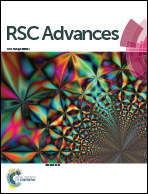Designing inorganic–magnetic–organic nanohybrids for producing effective photocatalysts for the purification of water
Abstract
The present study describes a new strategy for modifying the structure of zinc oxide for removing colored pollutants from water after a few minutes of light irradiation. In this context, the magnetic nanocomposite was combined with the nanolayers of Al/Zn to build inorganic–magnetic nanohybrids. The long chains of hydrocarbons of stearic acid have been used as pillars to widen interlayered spacing among the nanolayers to build organic–magnetic–inorganic nanohybrids. These nanohybrids were used as sources for designing zinc oxide nanohybrids to purify water from the green dyes using UV-light. The optical measurements showed that the nanohybrid structure of zinc oxide led to a clear reduction in the band gap energy from 3.30 eV to 2.75 eV to be more effective. In addition, a complete removal of naphthol green B was achieved after 15 min in the presence of zinc oxide nanohybrid using UV-light. The kinetic study showed that the reaction rate for the photocatalytic degradation of the pollutants was faster than that of the conventional photocatalysts. Finally, this strategy for designing photoactive nanohybrids led to positive results for overcoming environment- and water-related problems using the fast technique for purifying water.



 Please wait while we load your content...
Please wait while we load your content...